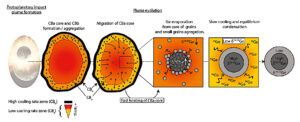Condensation and evaporation processes during CB chondrite formation : Insights from Ge isotopes and highly siderophile element abundances
Florin, G. ; Luais, B. ; Alard, O. ; Rushmer, T.
Voir en ligne : https://doi.org/10.1111/maps.13698

Abstract :
We analyzed the highly siderophile element (HSE) contents and bulk Ge isotopic compositions of large metal grains in the CB chondrites Bencubbin (CBa), Gujba (CBa), and HaH 237 (CBb). Our results suggest that the large grains were formed by the aggregation of smaller condensed grains, and the two Benccubinite groups are distinguishable based on their bulk metal δ74/70Ge mass-dependent isotopic values of 0.99 +- 0.30‰ (CBa) and −0.65 +- 0.10‰ (CBb). Based on our observations of these three samples, the isotopic compositions of metal in CBa chondrites are best explained by condensation at slow cooling rates in the center of an impact plume, whereas the metal in CBb chondrites formed under fast cooling rates along the plume edges. We also analyzed the Ge contents and isotopic compositions of the core, intermediate, and rim fractions of two Gujba metal grains, which were separated by sequential digestion. These results show a gradual decrease in δ74/70Ge and [Ge] from core to rim. We suggest that these δ74Ge zonations result from nearequilibrium condensation and evaporation processes in a heterogeneous plume. We propose a model for their formation in which (1) small grains (to become grain cores) condensed at equilibrium ; (2) these grains were transported to a warmer region of the plume where they reached temperatures lower than that of Fe-Ni condensation, but high enough for the rapid evaporation of Ge ; (3) Ge evaporation followed by slow cooling enriched the grains in heavy Ge isotopes and the surrounding gas in light Ge isotopes ; and (4) equilibrium recondensation of metal from the gas and around the small grains formed the light Ge isotopic zonations observed in grain rims.



